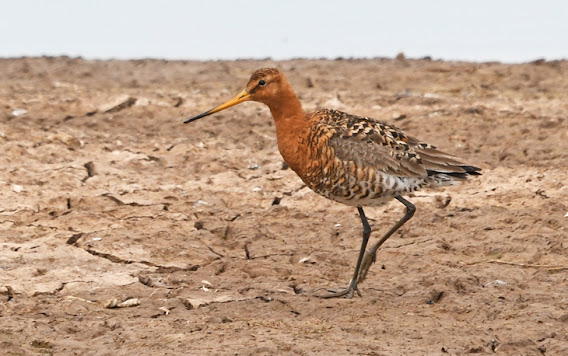Smithy Fen, near Cottenham (Cambs.) is a 40 minute drive from Royston. I've seen some good birds there, including a White Stork that was seen last summer. When (presumably) the same bird returned to the site this July, I popped up on the 4th to see it, perched on a lamppost. Adult and juvenile Little Ringed Plovers were also seen - this species seems to have had an excellent breeding season in 2023.
White Stork, Smithy Fen, 4 July
July is the month when wader species start to migrate through the UK as they return from their breeding grounds. One of the rarer species to pass through is Red-necked Phalarope, so when one turned up at RSPB Frampton Marsh I decided to return there on the 5th, just a fortnight after my visit to see the nesting Black-winged Stilts. The bird (the first that I've seen in the UK for five years) performed well in front of the East Hide although, it being rather tiny, my images didn't do it justice. I saw several adult Black-winged Stilts, in what has become a little haven for this species. Other waders seen included Ruff, Common and Green Sandpipers and a Greenshank, whilst hundreds of summer-plumaged Black-tailed Godwits were also present. At least six unusually active Spoonbills were also seen, making my visit well worthwhile!
Black-tailed Godwit, RSPB Frampton Marsh, 5 July
Black-winged Stilt, RSPB Frampton Marsh, 5 July
Red-necked Phalarope, RSPB Frampton Marsh, 5 July
Spoonbill, RSPB Frampton Marsh, 5 July
On the 12th I visited RSPB Strumpshaw Fen, hoping to see the juvenile Long-eared Owl that had been reported there earlier in the day. I assumed that it would stay at its roost site through the day, but when I arrived I discovered that it had been discovered by an RSPB volunteer sitting on a post with a rat in its talons, close to the Visitor Centre, but had subsequently disappeared. Seeing the amazing photos captured by RSPB staff was no consolation for missing the bird. At least I saw a White Admiral butterfly (my first and only 2023 sighting of this species) whilst I was there, before being caught in a thunderstorm that forced me to stay in the Tower Hide for 45 minutes.
On the way back from a rather wet weekend away in Lincolnshire, we stopped off on the 16th for a short time at Gibraltar Point NNR. Whilst my partner read the paper I had a quick look at the scrapes, which held a good variety of waders as well as Spoonbills, which are becoming more and more common along the East Coast.
Spoonbills (at the Back), Avocets and other birds at Gibraltar Point NNR on 16 July
On the 20th I returned to Thursley Common, looking on this occasion for dragonflies. I found five new species for 2023: Black Darter, Common Darter, Keeled Skimmer and Small Red and Emerald Damselflies. There was a lot of disturbance on the Moat Pond, which hindered and eventually thwarted my search for Brilliant Emerald dragonflies.
Mating Black-tailed Skimmers, Thursley Common, 20 July - how many Faces can you see?
Male Small Red Damselfly, Thursley Common, 20 July
My partner treated me to a special birthday present, in the form of an organised 'butterfly walk' at the Knepp 'Rewilding' Estate in West Sussex on the 22nd. The main target was Purple Emperor (this is the best place in the country to see these impressive butterflies) but, true to form, there was heavy rain throughout the walk, reducing our chances of seeing an 'emperor' to near zero. Despite the rain, this was a fascinating experience and one that will definitely be repeated in the future, although with bookings having to be made weeks in advance, we will again be entirely at the mercy of the elements. Whilst butterflies were in short supply, White Storks certainly were not - I was amazed to see six nests on the walk (there are eleven in total in 2023) and Knepp hopes to reach as many as 50 nests in the future! We were also able to visit the Beaver Dam: two Beavers are present in a large enclosure, but were not seen (they are nocturnal). However, there was plenty of evidence for their presence (see image, below). Turtle Doves nest here, but were no doubt sheltering from the rain on our visit.

Tree cut down by Beavers in their Enclosure, Knepp Estate, 22 July
I drove to Abberton Reservoir on the 25th, to see the moulting Slavonian Grebe that had taken up residence off the Layer Breton causeway. I had hoped to see the Wood Sandpiper and Ruddy Shelduck that had been reported at Hanningfield Reservoir on the way back, but didn't give myself enough time (the nature reserve is closed and locked at 5.00pm). With dire weather (yet again) forecast for the following few days, I also visited RSPB Minsmere in the same week (on the 27th), where I had distant views of a Little Stint and, after waiting patiently for around 90 minutes in the Bittern and Island Mere hides, I had my first, very brief view of the year of a Bittern (in flight).
Moulting Slavonian Grebe, Abberton Reservoir, 25 July










No comments:
Post a Comment